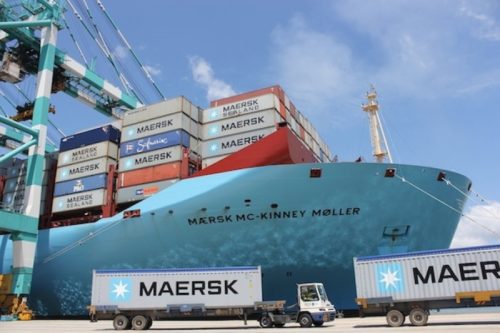
Container shipping and logistics giant AP Moller-Maersk remained in the red in the first quarter of 2019 with a $104m loss, although results were improved despite a weaker box shipping market.
Maersk’s Q1 2019 loss of $104m compared to $311m loss in the same period in 2018, once changes to accounting policies to IFRS 16 and the reintegration of Maersk Supply Service (MMS) previously classed as discontinuing operations, were taken into account. Revenues grew by 2.5% to $9.54bn in the first quarter of the year.
EBITDA for its core ocean, or container shipping, business grew by 42% to $927m in Q1 this year compared to the same period in 2018.
The improved result was primarily driven by an average load freight rate of $1,903 per feu, up from $1,832 per feu a year earlier, along with total operating costs that declined by 2.8%.
Improved rates came despite weaker growth in global container volumes of 1.7% in Q1 compared to average full year trade growth of 3.6% in 2018. For 2019 as whole the container trade is projected to grow 1 – 3%.
Looking ahead Maersk has now completed its restructuring selling its oil and tanker businesses, spinning off its rig business as a separate listed-business, and bring supply vessel owner MSS back into the company having failed to find a solution for it in current market conditions.
“We made good progress on the transformation, where we have completed the separation of the energy businesses, further integrated our organisation and continued to improve our product portfolio,” commented Soren Skou, ceo of AP Moller – Maersk.
Non-ocean business revenue grew by 3.8% in Q1, after adjustment for the closing of production facilities in Maersk Container Industry, and logistics & services improved gross profit by 2.2%.
“Non-ocean revenue and gross profit in logistics & services grew, but needs to accelerate in the coming quarters,” Skou said.
The company maintained its full year guidance of EBITDA of $5bn.
“We reaffirm our guidance for the 2019 results. We are still facing considerable uncertainties from weaker macro numbers as well as the risk from trade tensions and implementation of IMO 2020,” Skou said.
“In Q1, volumes on trans-Pacific trade between Asia and North America have shown signs of decline and new tariffs can potentially reduce expected growth in global container volumes by up to 1 percentage point.”
